Quick Summary
Learn how to hem relaxed jeans perfectly using a simple hydrogen peroxide solution. Get a clean, professional look without sewing, saving time and money. This easy method works great for achieving the ideal length and a crisp finish on your favorite denim.
How To Hem Relaxed Jeans: The Genius Peroxide Solution
It’s a common frustration: your favorite relaxed-fit jeans are just a touch too long. They drag on the ground, get dirty easily, and just don’t sit right. You want them shorter, but the thought of sewing, cutting, and potentially ruining your beloved denim can be daunting. Many assume altering jeans requires a sewing machine and fancy skills, but there’s a surprisingly simple, no-sew method that delivers fantastic results every time. We’re going to show you how to get that perfect hem using a common household item.
This article will guide you through a clever, beginner-friendly technique using hydrogen peroxide to create a clean, sharp hem on your relaxed jeans. No needles, no complex stitches – just straightforward steps that turn a common clothing problem into a simple DIY fix. By the end, you’ll have jeans that fit perfectly and look like they were professionally altered, all done from the comfort of your own home. Let’s get started and transform your denim!
Why Hydrogen Peroxide for Hemming Jeans?
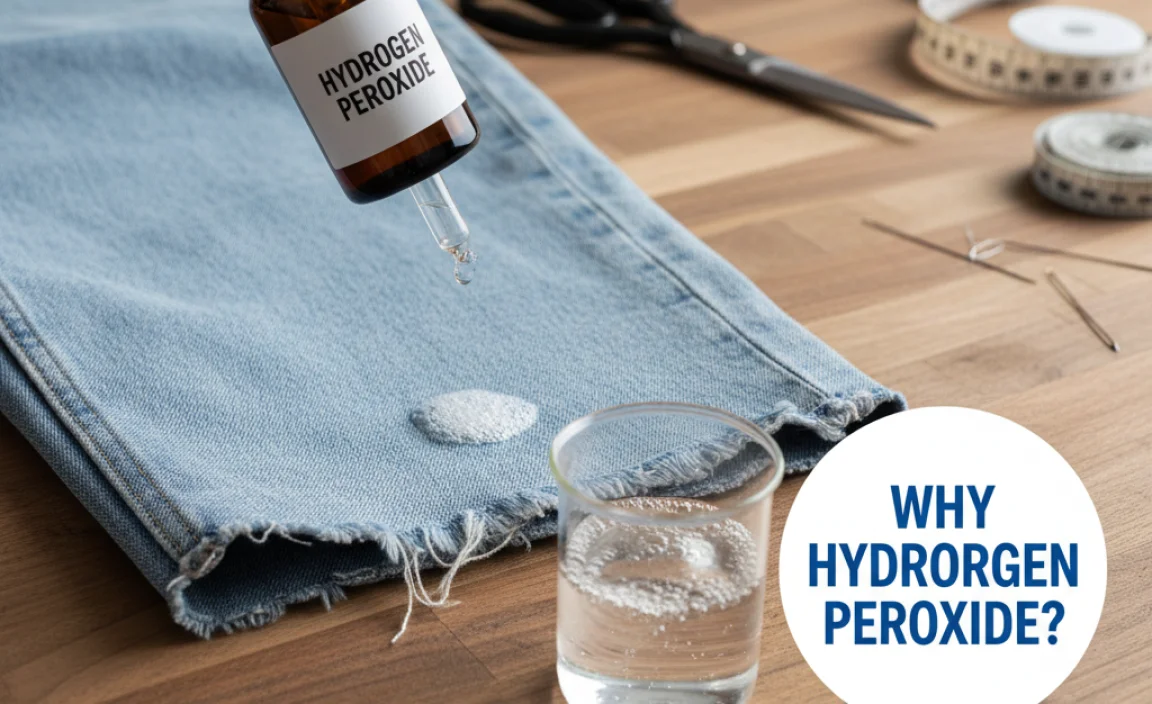
You might be wondering why hydrogen peroxide, usually found in a medicine cabinet, would be your go-to for hemming jeans. The magic lies in its oxidizing properties. When applied to fabric, especially denim, and exposed to heat (like through ironing), it can create a crisp, almost fused edge.
Unlike traditional hemming that involves sewing, this method creates a “no-sew” hem. It essentially bonds the fabric layers together, giving you a clean finish without stitching. This is particularly effective for relaxed-fit jeans where a sharp, defined hem can elevate the entire look, preventing that shapeless drape that can sometimes happen with overly long denim.
Benefits of the Peroxide Hemming Method
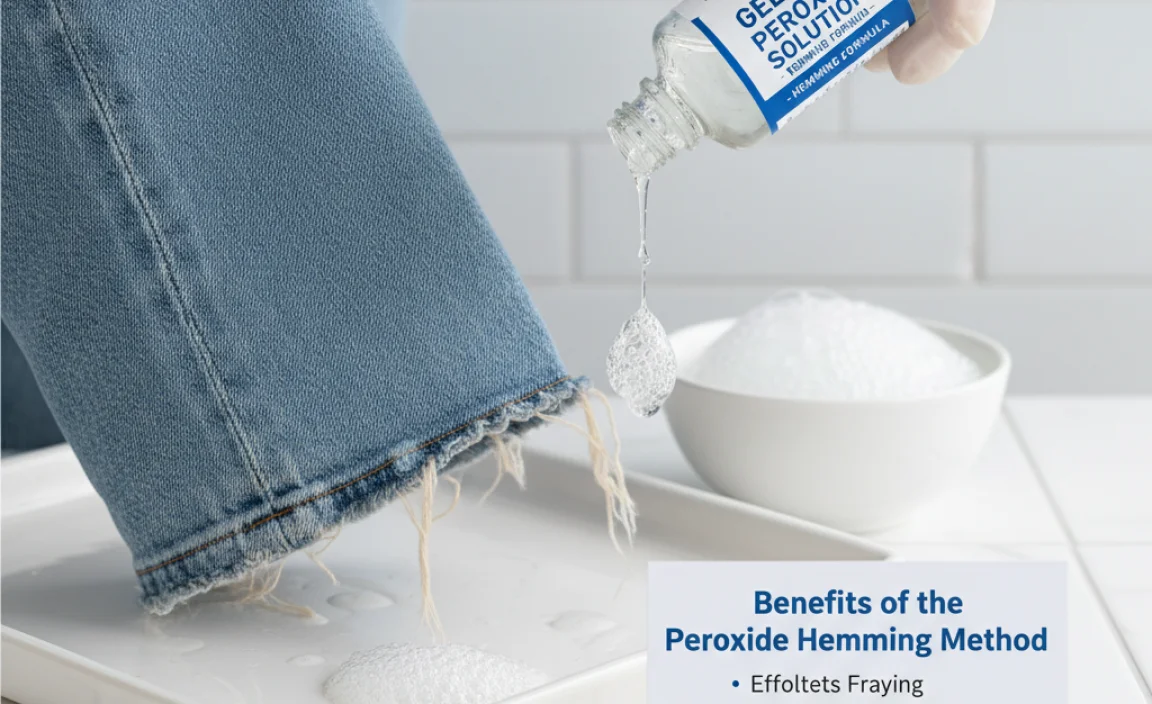
This ingenious technique offers a host of advantages:
- No Sewing Required: Perfect for those who don’t have a sewing machine or lack sewing confidence.
- Quick and Easy: Significantly faster than traditional hemming methods.
- Crisp, Professional Finish: Creates a sharp edge that looks intentionally done.
- Cost-Effective: Uses readily available household items, saving you money on tailoring.
- Adjustable: You can easily adjust the length to your exact preference.
- Durable: When done correctly, the hem can be surprisingly robust.
What You’ll Need
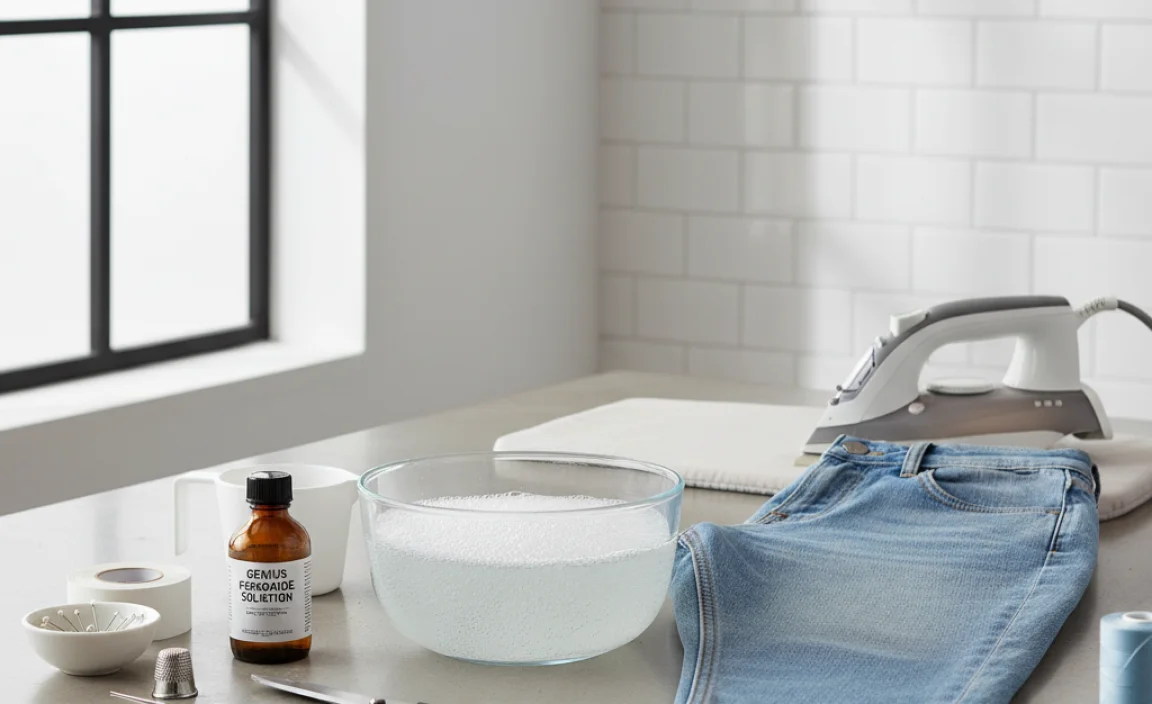
Gathering your supplies is the first crucial step to success. Make sure you have everything ready before you begin to ensure a smooth process.
Essential Tools:
- Your Relaxed Jeans: The star of the show! Make sure they are clean.
- Hydrogen Peroxide (3% Solution): Standard drugstore variety.
- Spray Bottle: To evenly apply the peroxide.
- Iron: For setting the hem.
- Ironing Board: A stable surface for ironing.
- Fabric Scissors (Optional, but Recommended): For a precise cut if you need to trim excess fabric.
- Measuring Tape or Ruler: For accurate length measurement.
- Fabric Chalk or a Pen: To mark your desired hemline.
- Cardboard or a Thick Magazine: To place inside the pant leg to prevent bleed-through.
- Small Bowl or Container: For mixing if needed, though direct spraying is often sufficient.
- Gloves (Optional): To protect your hands from the peroxide.
Step-by-Step Guide: Hemming Relaxed Jeans with Hydrogen Peroxide
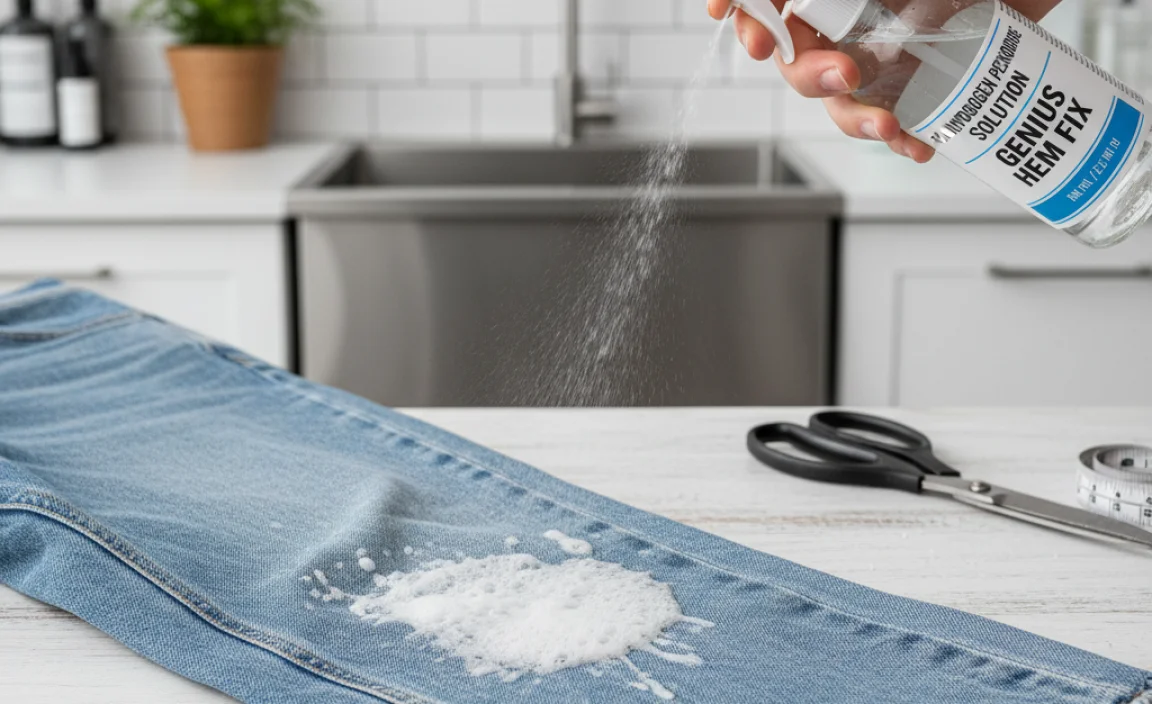
Follow these simple steps to achieve a flawless hem. Precision is key, so take your time with each stage.
Step 1: Determine Your Desired Length
Put on your relaxed jeans and stand in front of a mirror. Decide exactly how short you want them to be. Consider the shoes you’ll most likely wear with them. You can also lay them flat on the floor to help visualize the desired length.
Tip: It’s always better to err on the side of slightly too long than too short. You can always trim more later, but you can’t add fabric back.
Step 2: Mark Your Hemline
Once you’ve decided on the length, it’s time to mark. You can do this in a few ways:
- With Jeans On: If you’re comfortable, have someone else mark the spot with fabric chalk or a pen while you wear the jeans.
- With Jeans Off: Lay the jeans flat. Measure from the crotch down to where you want the hem to fall on one leg. Transfer this measurement to the other leg to ensure symmetry. Use your fabric chalk or pen to draw a line all the way around each leg at your desired finished length. Don’t forget to account for the amount of fabric you’ll fold over for the hem. A common hem allowance is about 1-1.5 inches (2.5-4 cm).
Step 3: Prepare the Pant Leg
Insert a piece of cardboard or a thick magazine inside the pant leg you’ll be working on. This prevents the hydrogen peroxide and heat from the iron from transferring to the other side of the pant leg, ensuring a clean, single-sided hem.
Step 4: Trim Excess Fabric (If Necessary)
If your jeans are significantly too long, you might want to trim off some excess fabric before hemming. Leave at least 1.5 to 2 inches (4-5 cm) below your marked hemline for folding. Use sharp fabric scissors for a clean, straight cut.
Consider the original hem: For a more authentic look, some people choose to cut just above the original hem and fold it up, then use the peroxide method to secure it. This preserves the original frayed edge for a “bootcut” or “distressed” look without sewing. If you want a clean, sharp hem, cut below the original hem.
Step 5: Fold and Prepare for Peroxide Application
Fold the bottom edge of the pant leg up towards the inside of the pant leg. This fold should align with your marked hemline (or just below it if you left extra fabric). Press the fold firmly with your hands. This creates the crease for your new hem.
For a double fold (recommended for a cleaner finish): Fold the raw edge up by about 1/2 inch (1.25 cm) towards the inside of the pant leg. Press this fold. Then, fold it up again by about 1 to 1.5 inches (2.5-4 cm) to meet your marked hemline. Press this second fold firmly. This creates a clean, double-folded hem that hides the raw edge.
Step 6: Apply Hydrogen Peroxide
Fill your spray bottle with 3% hydrogen peroxide. Lightly and evenly spray the folded section of the denim. You want the fabric to be damp, but not soaking wet. Ensure you spray the underside of the fold as well, where the fabric will be pressed together.
Tip: Test on an inconspicuous area first, like an inside seam, to ensure the peroxide doesn’t cause unwanted discoloration on your specific pair of jeans.
Step 7: Iron to Set the Hem
Place your iron on a medium-high heat setting (cotton blend is usually good for denim). With firm pressure, start ironing over the folded and sprayed section of the hem. Move the iron slowly and deliberately, pressing down firmly. You are essentially “fusing” the folded layers together with the heat and the oxidizing action of the peroxide. Continue ironing until the area is completely dry and feels stiff.
Important: Ensure the cardboard/magazine is still inside the pant leg to prevent bleed-through. You may need to iron for several minutes to ensure the peroxide has fully evaporated and the bond has set.
Step 8: Let it Cool and Inspect
Once ironing is complete, let the hem cool down completely. This is crucial for the bond to set properly. After it’s cooled, remove the cardboard from inside the pant leg. Gently test the hem by tugging slightly at the fabric. It should feel firm and hold its shape.
Step 9: Repeat for the Other Leg
Once you’re satisfied with the first hem, repeat all the steps for the other pant leg, ensuring it matches the first perfectly in length and appearance.
Step 10: Final Touches
Try on your newly hemmed jeans! Check the length and the look of the hem. If you need to make further adjustments, you can carefully unfold, re-mark, refold, and re-iron. For a more relaxed, lived-in look, you can gently fray the edges of the hem slightly with a fine-toothed comb or by hand after the peroxide has fully set.
Table: Peroxide Hemming vs. Traditional Hemming
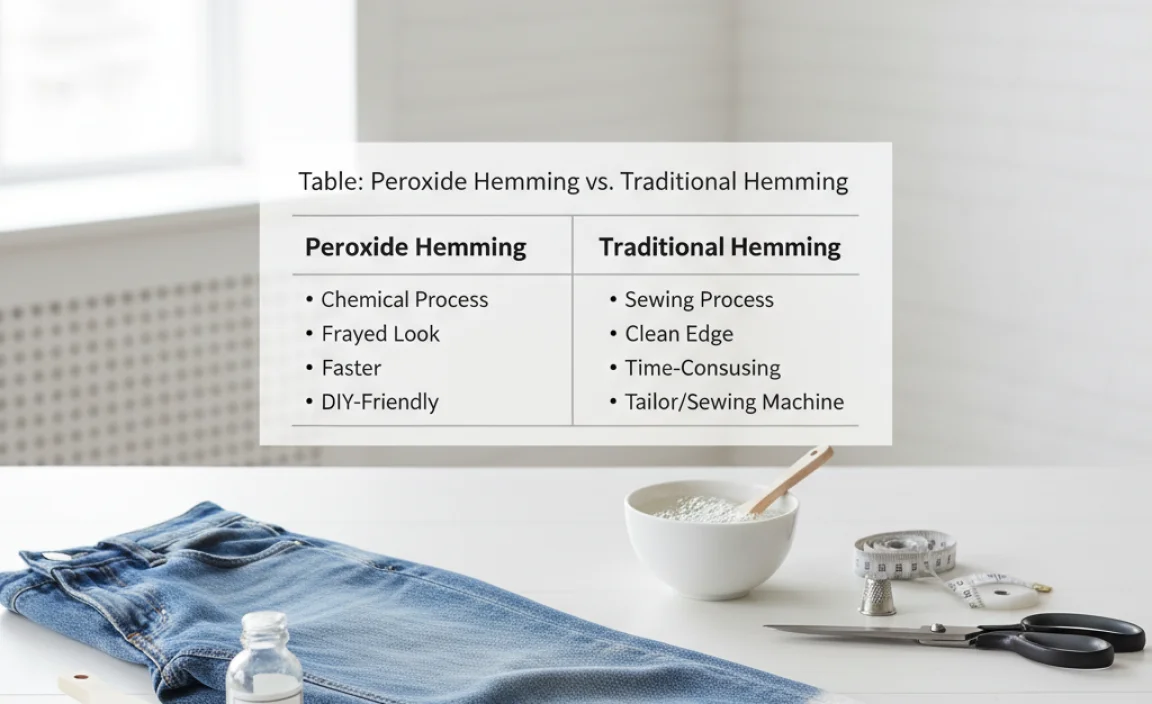
Here’s a quick comparison to highlight why the peroxide method is a fantastic option for many.
| Feature | Peroxide Hemming | Traditional Sewing |
|---|---|---|
| Skill Level | Beginner | Intermediate to Advanced |
| Tools Needed | Household items (peroxide, iron, spray bottle) | Sewing machine, needles, thread, pins |
| Time Commitment | Quick (under 1 hour) | Time-consuming (can take hours) |
| Ease of Alteration | Very Easy | Requires practice and precision |
| Finish Style | Crisp, fused edge; can mimic a sewn hem | Stitched seam; variety of stitch types possible |
| Durability | Good, with proper application | Excellent, with good stitching |
| Cost | Very low | Moderate (supplies, potential professional fee) |
Troubleshooting Common Issues
Even with straightforward methods, sometimes things don’t go exactly to plan. Here are a few common issues and how to fix them.
Issue: The Hem Isn’t Holding Firmly
Cause: Insufficient peroxide, not enough heat, or not ironing long enough. The fabric layers didn’t properly bond.
Solution: Carefully unfold the hem. Re-dampen the folded edge with peroxide, ensuring it saturates the area where the two fabric layers meet. Iron again for a longer duration, applying firm pressure. Make sure the iron gets hot enough.
Issue: Stiff, Unnatural-Feeling Hem
Cause: Too much peroxide was used, or the area wasn’t ironed thoroughly to evaporate all the liquid.
Solution: This is harder to fix perfectly. You can try to soften the hem by carefully bending and manipulating the fabric. Repeated washing may also help. In the future, use less peroxide and ensure the area is completely dry from ironing before letting it cool.
Issue: Accidental Staining or Discoloration
Cause: Peroxide can sometimes bleach denim unpredictably, especially if it’s a weaker wash or if left on too long without ironing. The cardboard may have shifted, allowing bleed-through.
Solution: This is the trickiest. If the stain is slight, you might be able to disguise it by intentionally distressing that part of the jeans or adding a patch. More significant discoloration might mean re-doing the hem on a different pair of jeans or accepting it as part of the unique character of your altered pants. Always test on an inconspicuous area first if you’re concerned about your specific denim.
Issue: Uneven Hem
Cause: Inaccurate marking, inconsistent folding, or a bent ironing board.
Solution: The best course is to carefully unfold the hem, re-mark your guideline accurately, refold precisely, and re-iron. Taking extra care during the marking and folding stages is key. Ensure your working surface is flat and stable.
Frequently Asked Questions (FAQ)
- Q1: Can I use a stronger hydrogen peroxide solution?
- It’s best to stick with the standard 3% solution available at most drugstores. Stronger concentrations are more potent and can lead to unpredictable bleaching and fabric damage. The 3% is sufficient for bonding denim when combined with heat.
- Q2: Will this method work on other types of fabric?
- This method is most effective on denim and similar sturdy cotton weaves like twill. It might not work well on very thin, delicate, or synthetic fabrics, as they may not hold the fold or react well to the heat and peroxide combination.
- Q3: How long will the hem last?
- When done correctly, the peroxide hem can be quite durable and last for a long time. However, it’s not as permanent as sewing. Washing and drying on high heat might eventually loosen the bond. Gentle washing cycles will help preserve the hem.
- Q4: What’s the best way to wash jeans after hemming with peroxide?
- To maintain the integrity of the hem, it’s recommended to wash your jeans inside out in cold water on a gentle cycle. Air drying or using a low heat setting in the dryer is best. Avoid harsh detergents or aggressive washing.
- Q5: Can I dye my jeans after using this method?
- While it’s possible, dyeing heavily treated or bonded fabric can be unpredictable. The peroxide might alter the way the dye takes. If you plan to dye, it’s often best to do so before trying to hem them, or accept that the hem area might dye differently.
- Q6: How do I achieve a raw, frayed hem look with this method?
- To create a frayed hem, you’d typically cut the jeans to your desired length, then fray the edge naturally through wear or by carefully pulling threads. This peroxide method is more for creating a clean, finished hem. If you want a frayed look, it’s usually done by other means and not as part of a fused hem.
Maintaining Your Hemmed Jeans
Proper care is essential to ensure your newly hemmed relaxed jeans look great for as long as possible. As mentioned, washing your jeans inside out in cold water on a gentle cycle using a mild detergent is key. Avoid using bleach, as it can weaken the fabric and potentially interact with any residual peroxide. Tumble drying on a low heat setting or, ideally, air drying will help preserve the integrity of the fused hem.
If you notice any loosening over time, you can always re-apply the peroxide and iron the hem again to reinforce the bond. Regular inspection of the hem area can help you catch any issues before they become significant problems. Think of this method as offering a robust, but not indestructible, bond.
Beyond Hemming: Other Uses for Hydrogen Peroxide in Clothing Care
Hydrogen peroxide is surprisingly versatile when it comes to clothing care. Beyond its use in no-sew hemming, it can act as a natural and gentle bleaching agent for whites. If you have a stubborn stain on a white garment, a soak with hydrogen peroxide can often lift it effectively without the harshness of chlorine bleach. For example, according to the U.S. Environmental Protection Agency (EPA), hydrogen peroxide is considered a greener cleaning choice for some applications, breaking down into water and oxygen.
It can also be used to treat mildew or mold stains on fabric. Apply directly or soak the affected area. Always remember to test it on an inconspicuous spot first, especially on colored fabrics, as it can cause fading. For denim, its ability to create a crisp edge through heat activation is its most unique application for DIY fashion fixes.
Conclusion
Hemming your relaxed jeans doesn’t have to be a daunting or expensive task. The hydrogen peroxide method offers a straightforward, accessible, and effective way to achieve a professional-looking, no-sew hem right in your own home. By following these clear, step-by-step instructions, you can easily tailor your favorite denim to the perfect length, eliminating the frustration of dragging hems and the cost of professional alterations.
You now have the knowledge to transform your jeans, giving them a clean finish and a better fit. Remember to take your time, measure carefully, and use the heat of your iron to create a crisp, lasting fold. Enjoy your perfectly hemmed relaxed jeans, and feel confident in your ability to tackle simple clothing alterations with everyday items. Happy hemming!











